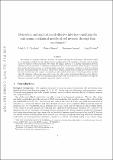Files in this item
Derivation and application of effective interface conditions for continuum mechanical models of cell invasion through thin membranes
Item metadata
| dc.contributor.author | Chaplain, Mark Andrew Joseph | |
| dc.contributor.author | Giverso, Chiara | |
| dc.contributor.author | Lorenzi, Tommaso | |
| dc.contributor.author | Preziosi, Luigi | |
| dc.date.accessioned | 2019-07-31T10:30:03Z | |
| dc.date.available | 2019-07-31T10:30:03Z | |
| dc.date.issued | 2019 | |
| dc.identifier | 260335515 | |
| dc.identifier | 3fc2d092-d39b-43c0-9ff1-5de0195bf863 | |
| dc.identifier | 85077400155 | |
| dc.identifier | 000493900600017 | |
| dc.identifier.citation | Chaplain , M A J , Giverso , C , Lorenzi , T & Preziosi , L 2019 , ' Derivation and application of effective interface conditions for continuum mechanical models of cell invasion through thin membranes ' , SIAM Journal on Applied Mathematics , vol. 79 , no. 5 , pp. 2011–2031 . https://doi.org/10.1137/19M124263X | en |
| dc.identifier.issn | 0036-1399 | |
| dc.identifier.other | ORCID: /0000-0001-5727-2160/work/63716860 | |
| dc.identifier.uri | https://hdl.handle.net/10023/18211 | |
| dc.description | Funding: UK EPSRC grant no. EP/N014642/1. | en |
| dc.description.abstract | We consider a continuum mechanical model of cell invasion through thin membranes. The model consists of a transmission problem for cell volume fraction complemented with continuity of stresses and mass flux across the surfaces of the membranes. We reduce the original problem to a limiting transmission problem whereby each thin membrane is replaced by an effective interface, and we develop a formal asymptotic method that enables the derivation of a set of biophysically consistent transmission conditions to close the limiting problem. The formal results obtained are validated via numerical simulations showing that the relative error between the solutions to the original transmission problem and the solutions to the limiting problem vanishes when the thickness of the membranes tends to zero. In order to show potential applications of our effective interface conditions, we employ the limiting transmission problem to model cancer cell invasion through the basement membrane and the metastatic spread of ovarian carcinoma. | |
| dc.format.extent | 21 | |
| dc.format.extent | 7167585 | |
| dc.language.iso | eng | |
| dc.relation.ispartof | SIAM Journal on Applied Mathematics | en |
| dc.subject | Continuum mechanics | en |
| dc.subject | Thin membranes | en |
| dc.subject | Effective interface conditions | en |
| dc.subject | Cell invasion | en |
| dc.subject | Basement membrane | en |
| dc.subject | Ovarian cancer | en |
| dc.subject | QA Mathematics | en |
| dc.subject | QH301 Biology | en |
| dc.subject | RC0254 Neoplasms. Tumors. Oncology (including Cancer) | en |
| dc.subject | T-NDAS | en |
| dc.subject | SDG 3 - Good Health and Well-being | en |
| dc.subject.lcc | QA | en |
| dc.subject.lcc | QH301 | en |
| dc.subject.lcc | RC0254 | en |
| dc.title | Derivation and application of effective interface conditions for continuum mechanical models of cell invasion through thin membranes | en |
| dc.type | Journal article | en |
| dc.contributor.sponsor | EPSRC | en |
| dc.contributor.institution | University of St Andrews. School of Mathematics and Statistics | en |
| dc.contributor.institution | University of St Andrews. Applied Mathematics | en |
| dc.identifier.doi | https://doi.org/10.1137/19M124263X | |
| dc.description.status | Peer reviewed | en |
| dc.identifier.grantnumber | EP/N014642/1 | en |
This item appears in the following Collection(s)
Items in the St Andrews Research Repository are protected by copyright, with all rights reserved, unless otherwise indicated.

